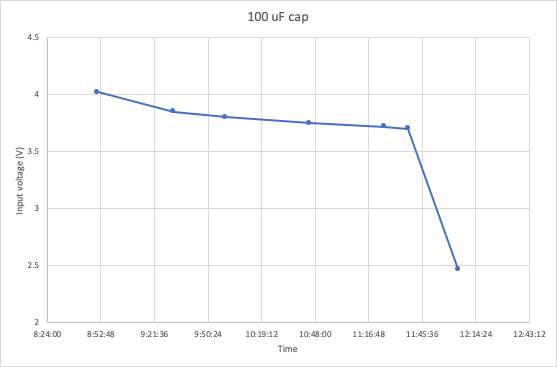Hi,
I’ve just bought a PowerBoost 500 basic to provide 5V to a Teensy 3.6. I’ve attached a terminal block to the Bat and GND pins so I can plug in 3 NiMH batteries placed in a 3xAA enclosure. I’ve kept the wires as short as possible as inductance is a potential problem (there’s a warning in the tutorial about this). I’ve put a switch between the EN and GND pins to act as an on/off switch for the unit. Photos of the assembled unit below.
If I use a LiPo battery (straight in to the JST socket on the board) then everything works fine. However, with the NiMH batteries, all fully charged, things go well for the first few hours but then just one of the 3 AA batteries loses all its charge. It’s always the battery closest to earth in the circuit too. The other two still have ~1.2V but the other is 0.
I have no idea what’s going on here. Is there a way to solve this problem as I have a lot of NiMH batteries, and it seems a shame not to use them?
I’ve checked all the wiring, there are no shorts and the batteries are in the correct orientation.
There is quite a long wire on the back of the enclosure which may be causing some issues??
Hi Jim,
Probably the first go to would be to add a nice fat, very low leakage capacitor on the input. There is a 10uF cap on board, but a bigger one to really be sure of decoupling the batteries from the boost circuit couldn’t hurt. This will smooth loading on the batteries and may help pro-long life.
I’d also recommend putting your switch on the batteries, not the Enable pin to ensure no parasitic drain while it’s off.
As for losing power, quite simply NiMHs aren’t as energy-dense as a lipo, and if they are old its possible they are suffering from memory effects, so aren’t able to provide their rated capacity. To clarify is it always a specific battery that goes flat first, or the one on the negative even when the battery order is changed?
I doubt the wire on the back of the enclosure is causing your issues.
Regards,
Oliver
Support | Core Electronics
Hi Oliver,
Thanks very much for that. The biggest capacitor I have to hand is a 100 uF / 16V which I put across the battery output:
I then ran the Teensy again and monitored the voltage levels on all three (different, fresh) batteries. Again the one closest to earth lost charge after a little over 3 hours. The plot shows the total voltage at the input to the PowerBoost with the teensy powered down:

So it’s been the same battery position both times but different physical batteries for all three.
Maybe I need a bigger capacitor?
Oh, and just sitting on the bench with nothing turned on, that battery is now reading 1.14V. But as soon as I put a load on the circuit, it drops back down to nothing.
Cheers,
Jim
Hi Jim,
It may well be that the battery is just going flat, and possibly also that your cells are suffering a memory effect. I suspect it may just be pure chance that the one closest to earth is the one going flat first (although I do have a bit of a hypothesis based on actual charge movement). You’ll need to be really methodical about testing your batteries to be sure it is related to their position in the pack, and not just that a lower capacity cell is closest to earth.
Sticking that nice fat capacitor on there should eliminate any pulse discharging that may have been occurring.
NiMh’s do have a very abrupt voltage drop at the end of their capacity.
There’s a good thread on the candlepower forums about this very thing (Batteries and LEDs are those guys bread and butter):
https://www.candlepowerforums.com/vb/showthread.php?362687-4x-AA-NiMH-in-series-discharge-different-rates-Why
I’m not entirely clear on why else it might be. I’d suggest checking out some engineering guides from panasonic and energizer, as these are a fantastic resource:
https://www.mouser.com/pdfdocs/PanasonicBatteries_NI-MH_Handbook.pdf
And checkout some AA battery tests (including a few NiMhs) here:
https://lygte-info.dk/info/BatteriesLowCurrentDischarge2%20UK.html#AA,_Leise_NiMH_2500mAh
https://lygte-info.dk/info/ComparisonOfAABatteryChemistry%20UK.html
Regards,
Oliver
Support | Core Electronics
Hi Oliver,
Thanks very much for all of that!
It turns out that those two batteries going flat in the same location was a coincidence as you suspected. I’ve since tested all the old batteries and found a wide range in performance, some lasting less than a couple of hours, others going for up to 12 hours. When one of them dies, the PowerBoost doesn’t get enough voltage and everything stops.
Yes, that abrupt drop in the NiMHs was pretty clear!
Thanks again for your help. I’ve culled the dodgy batteries and now have a stash of good ones 
Cheers,
Jim
1 Like
Hi Jim,
No worries, glad you’ve got it sorted!
Regards,
Oliver
Support | Core Electronics
This is always a problem when mixing batteries with different usage history. It may be possible to rejuvenate the dud batteries with a few cycles of fully charging/fully discharging the affected batteries. If the battery is suffering from voltage depletion/memory effect this usually works.
1 Like





